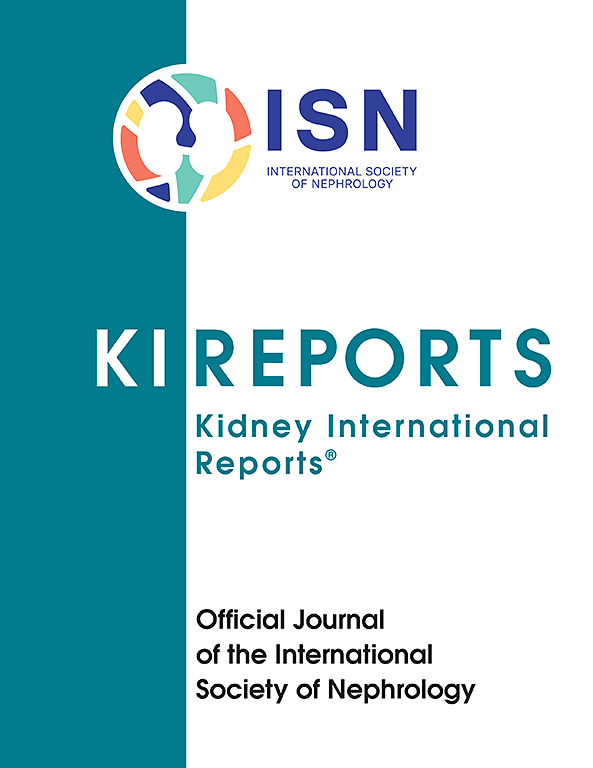FAM47E-SHROOM3单倍型在普通人群样本中的临床和代谢特征
IF 5.7
2区 医学
Q1 UROLOGY & NEPHROLOGY
引用次数: 0
摘要
全基因组关联研究(GWAS)在染色体4q21.1上发现了一个位点,该位点跨越序列相似家族47成员E (FAM47E)、淀粉结合结构域1 (STBD1)、含螺旋结构域158 (CCDC158)和蘑菇家族成员3 (SHROOM3)基因,与肾功能标志物相关。功能研究表明SHROOM3是效应基因,证明其在保证足细胞屏障完整性方面的发育作用。然而,该位点也与其他临床特征有关,包括电解质、血液学、心血管和神经学特征,并不是所有这些都可以很容易地追溯到肾功能的调节。因此,我们对整个基因座的遗传谱(单倍型)进行了系统分析,以评估它们与哪些表型谱相关。方法根据当地全外显子组测序(WES)参考面板的基因型,对南蒂罗尔合作健康研究(CHRIS)的12834名参与者的这4个基因重建了71个外显子和内含子变异的单倍型。采用线性回归模型检测单倍型与72种临床特征、170种血清代谢物和148种血浆蛋白浓度的相关性。结果共鉴定出11个单倍型,种群频率在2% ~ 24%之间。与最常见的单倍型相比,大多数单倍型与较高的基于肌酐的肾小球滤过率(eGFR)和较低的血清镁水平相关。此外,特定的单倍型还与多种生物性状相关,包括蛋白尿、血压、红细胞性状、肉碱和氨基酸。聚类分析强调了不同遗传谱的存在,其中具有特定单倍型的个体具有特定的表型和代谢特征。结论FAM47E-SHROOM3位点的遗传变异性表明存在具有不同生物标记谱的种群亚群。本文章由计算机程序翻译,如有差异,请以英文原文为准。

Clinical and Metabolic Signatures of FAM47E–SHROOM3 Haplotypes in a General Population Sample
Introduction
Genome-wide association studies (GWAS) identified a locus on chromosome 4q21.1, spanning the Family With Sequence Similarity 47 Member E (FAM47E), Starch Binding Domain 1 (STBD1), Coiled-Coil Domain Containing 158 (CCDC158), and Shroom Family Member 3 (SHROOM3) genes, to be associated with kidney function markers. Functional studies implicated SHROOM3 as the effector gene, demonstrating its developmental role to guarantee podocyte barrier integrity. However, the locus has also been associated with other clinical traits, including electrolytes, hematological, cardiovascular, and neurological traits, not all of which can be easily traced to the regulation of kidney function. We therefore conducted a systematic analysis of the whole locus’ genetic profiles (haplotypes) to assess which phenotypic profiles they were associated with.
Methods
For the 4 genes, we reconstructed haplotypes spanning 71 exonic and intronic variants for 12,834 participants in the Cooperative Health Research in South Tyrol (CHRIS) study based on genotypes imputed on a local whole-exome sequencing (WES) reference panel. Haplotypes were tested for associations with 72 clinical traits, 170 serum metabolites, and 148 plasma protein concentrations, using linear regression models.
Results
We identified 11 haplotypes with a population frequency between 2% and 24%. Compared with the most common haplotype, most haplotypes were associated with higher creatinine-based estimated glomerular filtration rate (eGFR) and lower serum magnesium levels. In addition, specific haplotypes were also associated with biologically diverse groups of traits, including albuminuria, blood pressure, red blood cell traits, carnitines, and amino acids. Cluster analysis highlighted the existence of distinct genetic profiles in which individuals with specific haplotypes presented with specific phenotypic and metabolic signatures.
Conclusion
The genetic variability of the FAM47E–SHROOM3 locus indicates the existence of population subgroups with distinct biomarker profiles.
求助全文
通过发布文献求助,成功后即可免费获取论文全文。
去求助
来源期刊

Kidney International Reports
Medicine-Nephrology
CiteScore
7.70
自引率
3.30%
发文量
1578
审稿时长
8 weeks
期刊介绍:
Kidney International Reports, an official journal of the International Society of Nephrology, is a peer-reviewed, open access journal devoted to the publication of leading research and developments related to kidney disease. With the primary aim of contributing to improved care of patients with kidney disease, the journal will publish original clinical and select translational articles and educational content related to the pathogenesis, evaluation and management of acute and chronic kidney disease, end stage renal disease (including transplantation), acid-base, fluid and electrolyte disturbances and hypertension. Of particular interest are submissions related to clinical trials, epidemiology, systematic reviews (including meta-analyses) and outcomes research. The journal will also provide a platform for wider dissemination of national and regional guidelines as well as consensus meeting reports.
 求助内容:
求助内容: 应助结果提醒方式:
应助结果提醒方式:


